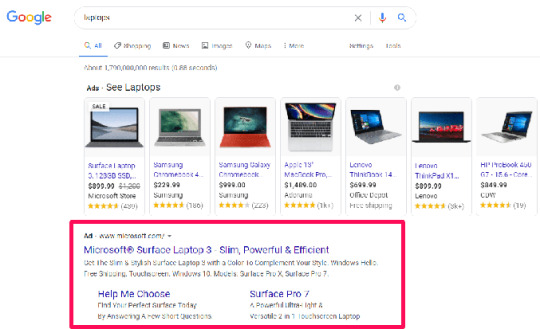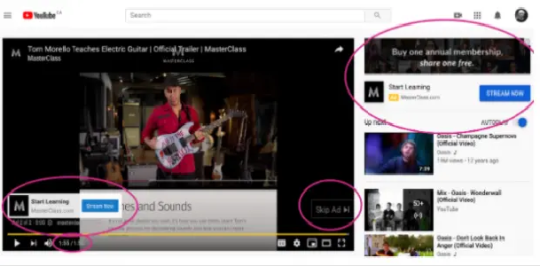#digital advertising tips
Explore tagged Tumblr posts
Text
How Does Tracking Work on Google Ads?

In today's digital marketing landscape, understanding how your advertising campaigns perform is crucial for optimizing efforts and maximizing return on investment (ROI). Google Ads offers robust tracking tools that enable marketers to measure success accurately and make informed decisions. In this blog, we'll explore how tracking works in Google Ads, its key components, best practices, and tips for effective utilization.
1. Understanding Google Ads Tracking
Google Ads tracking is the process of collecting and analyzing data related to ad performance, user interactions, and conversion metrics. With this information, advertisers can refine their strategies, enhance audience targeting, and improve campaign effectiveness.
2. Key Components of Google Ads Tracking
a. Conversion Tracking
Conversion tracking is a fundamental aspect of Google Ads. It allows advertisers to measure specific actions users take after interacting with their ads, such as:
Purchases: Understanding sales generated through ads.
Sign-Ups: Tracking newsletter subscriptions or account creations.
Form Submissions: Monitoring contact form completions.
Fact: According to Google, advertisers using conversion tracking see an average increase of 20% in conversions.
How to Set Up:
Go to "Tools and Settings" in your Google Ads account.
Select "Conversions" and create a new conversion action.
Implement the conversion tracking tag (pixel) on your website.
b. Google Analytics Integration
Integrating Google Analytics with Google Ads provides deeper insights into user behavior. By linking these platforms, you can:
Analyze metrics like bounce rate, session duration, and page views.
Gain insights into audience demographics and interests.
Track user pathways from ad click to final conversion.
Tip: Make sure to set up goals in Google Analytics that align with your conversion actions in Google Ads for comprehensive tracking.
c. Tracking URL Parameters
URL parameters allow advertisers to track the performance of specific campaigns, ad groups, or keywords. By appending tracking parameters to your destination URLs, you can gather detailed information about how users arrived at your site.
Common Parameters:
utm_source: Identifies the source of traffic (e.g., Google, Facebook).
utm_medium: Indicates the medium used (e.g., CPC, email).
utm_campaign: Defines the campaign name for tracking.
Trick: Use Google’s Campaign URL Builder to easily create tagged URLs.
3. Advanced Tracking Features
a. Remarketing Lists for Search Ads (RLSA)
RLSA allows you to tailor your search ads for users who have previously visited your website. By tracking user behavior, you can create specific audience segments and adjust your bidding and messaging accordingly.
Fact: Businesses using RLSA see an average conversion rate increase of 50%.
b. Enhanced Ecommerce Tracking
For e-commerce websites, Enhanced Ecommerce tracking provides in-depth insights into the shopping behavior of users. It tracks product impressions, clicks, add-to-cart actions, and more.
Tip: Implement Enhanced Ecommerce tracking to analyze user behavior at each stage of the buying process.
4. Analyzing and Interpreting Data
Once your tracking is set up, analyzing the data is crucial for understanding campaign performance. Focus on key metrics:
Click-Through Rate (CTR): Measures how often people click your ad after seeing it. A higher CTR indicates effective ad copy and targeting.Tip: Test different ad copy and visuals to find what resonates with your audience.
Cost per Acquisition (CPA): Calculates how much you spend to acquire a customer. Aim to lower your CPA while maintaining conversion rates.
Conversion Rate: The percentage of users who complete a desired action after clicking your ad. A higher conversion rate suggests effective targeting and ad relevance.
Return on Ad Spend (ROAS): Measures the revenue generated for every dollar spent on ads. A higher ROAS indicates a successful campaign.
Fact: Advertisers should aim for a ROAS of at least 400% (or a 4:1 ratio) to ensure profitability.
5. The Importance of Google Ads Tracking
Effective tracking in Google Ads is essential for several reasons:
Informed Decision-Making: Understanding which ads and keywords perform best allows for better budget allocation.
Optimization Opportunities: Tracking helps identify underperforming ads, keywords, or targeting options, enabling marketers to refine their strategies.
ROI Measurement: Knowing the ROI of your campaigns helps justify your advertising spend and demonstrates the value of your marketing efforts.
6. Best Practices for Google Ads Tracking
Regularly Review Your Data: Set a schedule to review performance data and adjust your campaigns accordingly.
A/B Testing: Continuously test different ad elements (headlines, descriptions, images) to identify the most effective combinations.
Use Automated Rules: Google Ads allows you to set automated rules for adjusting bids, pausing ads, or changing budgets based on performance metrics.
Keep Your Tags Organized: Use descriptive names for conversion actions and tracking parameters to maintain clarity as your campaigns grow.
Conclusion
Google Ads tracking is a vital component of successful digital marketing. By implementing conversion tracking, integrating Google Analytics, and utilizing advanced tracking features, marketers can gain valuable insights into their campaigns' performance. This data-driven approach enables informed decision-making, optimization, and ultimately, better ROI. To implement effective SEO strategies for long-term growth, visit GoToGroww.com and connect with me to explore how we can elevate your business.
#Google Ads#Digital Marketing#Conversion Tracking#Online Advertising#PPC Management#Google Analytics#Marketing Strategy#Ad Performance#SEO and SEM#E-commerce Tracking#Digital Advertising Tips
0 notes
Text
Most Important PPC KPIs You Should Be Tracking: A Guide for Newbies
Advertising is crucial for every business. Spending sleepless nights and working relentlessly to create a path-breaking product could turn out to be futile if people never get to know about it. There are several advertising options available for marketers to choose from, including pay-per-click (PPC) marketing. PPC is an advertising model that allows you to display ads on web pages. It can be a…

View On WordPress
#Business#business advice tips#Content Marketing#content marketing strategy#digital advertising tips#Most Important PPC KPIs You Should Be Tracking: A Guide for Newbies#pay per click#ppc#PPC advertising#ppc marketing#PPC marketing plan#small business advices#small business tips
0 notes
Text

How to make a Skin Tone Palette!! 🎨
(ㆁωㆁ)🎉
Next lesson: Sub scatter
To support me you can follow me on
Twitter:
@kauteyogi
https://twitter.com/KAUTE_?t=cUtNrqBcPQa9qicffJ26lA&s=09
Instagram :
@kauteyogi
#artists on tumblr#artwork#digital illustration#marketing#poster#how to draw#colouring#drawing#drawing lessons#skin tone#art tips#digital art#art#advertising
70 notes
·
View notes
Text
🚨 Google Ads Outage & Autocomplete Issues: What You Need to Know! 🚨
If you’ve been managing Google Ads or using Google’s search functions recently, you might have encountered some notable disruptions. Here’s a brief overview:
🔧 Google Ads Outage: On August 1, 2024, Google Ads faced a significant outage affecting key features such as Report Editor, Dashboards, and Saved Reports. Many advertisers experienced difficulties accessing essential tools and data. If you’re among those affected, remember to:
- Check the Google Ads Status Dashboard for real-time updates 📊
- Document any campaign discrepancies 📋
- Communicate potential delays to your clients 📢
🔍 Autocomplete Clarifications: Additionally, Google recently addressed concerns about its Autocomplete feature. Users reported missing or outdated predictions, particularly for political queries. Google attributed these issues to outdated protections and bugs but has since rolled out updates to enhance predictions and improve search accuracy 🔄.
These events underscore the dynamic nature of technology and the importance of staying informed. How have these issues affected your work or search experience? Share your thoughts and let’s navigate these challenges together! 💬👇
📌Follow us on Social Media📌
📢 LinkedIn — Vedang Kadia — Amazon Associate | LinkedIn
📢 Quora — Vedang Kadia
📢 Tumblr — Untitled
📢 Medium — Vedang Kadia — Medium

#google ads#digital marketing#autocomplete#advertising#google#marketing tips#marketing stratergies#tech news#tumbler#seo services#emailmarketing#openai#chatgpt#artificial intelligence#kim seokjin#google news#google ai#search engine optimization#ai#india#branding#marketing strategy#aesthetictumblr#tumblr aesthetic#tumblr stuff#facebook ads
2 notes
·
View notes
Text

Attract more visitors with a creative website
A well-designed website goes a long way in helping your brand establish an online presence and gain loyal customers. your design decisions not only impact your website’s performance but your brand recognition as well. A creative website design can provide Brand Credibility, User Retention, SERP Rankings, Seamless User Experience and many more. Alienspost provides you not only a creative website but also help in business gowth, reach your maximum target audience, marketing and improving your seach engine result by providing a good rank. Post your project on Alienspost and let your business shine in commercial society.
#business analysis#marketing tips#SEO#PPC#target audience#online services#business world#Alienspost#web development#digital marketing agency#website designer#advertising
9 notes
·
View notes
Text

What is marketing:-
Introduction
In the fast-paced world of digital marketing, staying ahead of the curve is crucial for businesses aiming to succeed in 2024 and beyond. With technological advancements and shifting consumer behaviors, the landscape of marketing continues to evolve rapidly. This blog explores key strategies and trends that businesses can leverage to thrive in today's digital age.
1. Understanding the Current Marketing Landscape
- Digital Transformation: How businesses are adapting to digital-first strategies.
- Consumer Behavior Shifts: The rise of mobile-first browsing and shopping.
- Data-Driven Insights: Harnessing big data for targeted marketing campaigns.
2. Key Digital Marketing Strategies
- Search Engine Optimization (SEO): Best practices for ranking high on search engines.
- Content Marketing: Creating valuable content to engage and convert customers.
- Social Media Marketing: Leveraging platforms like Facebook, Instagram, and TikTok for brand awareness and customer engagement.
- Email Marketing: Building effective email campaigns for lead nurturing and customer retention.
- Paid Advertising: Maximizing ROI through Google Ads, Facebook Ads, and other paid channels.
3. Emerging Trends in 2024
- AI and Machine Learning: How AI is transforming marketing automation and personalized customer experiences.
- Voice Search Optimization: Optimizing content for voice search queries.
- Augmented Reality (AR) and Virtual Reality (VR): Enhancing customer engagement through immersive experiences.
- Blockchain Technology: Ensuring transparency and security in digital marketing efforts.
4. Case Studies and Success Stories
- Case Study 1: How Company X achieved a 200% increase in sales through an innovative digital marketing campaign.
- Case Study 2: Lessons learned from Company Y's successful social media influencer collaboration.
- Case Study 3: Implementing AI-driven strategies at Company Z: A roadmap to success.
5. The Future of Marketing: Predictions and Recommendations
- Personalization: Tailoring marketing efforts to individual consumer preferences.
- Ethical Marketing: Building trust and credibility through ethical practices.
- Continuous Learning: The importance of staying updated with industry trends and evolving technologies.
Conclusion
As we move further into 2024, digital marketing will continue to evolve, presenting both challenges and opportunities for businesses. By embracing innovative strategies, leveraging new technologies, and staying agile, businesses can position themselves for success in the ever-changing digital landscape.
Call to Action
Ready to take your marketing efforts to the next level in 2024? Contact us today to learn how our tailored strategies can help your business thrive in the digital age.
This outline provides a comprehensive framework for a 1500-word blog post on digital marketing. You can expand each section with detailed explanations, examples, and insights to provide value to your readers and establish your authority in the field.
2 notes
·
View notes
Text
#the silicon review#digital advertising#digital marketing#marketing#email marketing#email marketing tips
3 notes
·
View notes
Text
Google Ads to Promote Business
Google Ads is an online advertising platform developed by Google, where advertisers can bid on specific keywords or phrases to display their ads to a targeted audience.
Why use Google Ads? Google Ads is the most popular online advertising platform, with over 3.5 billion searches per day. It offers advanced targeting options, real-time reporting, and a variety of ad formats to suit your business needs.

Benefits of using Google Ads: Using Google Ads (formerly known as Google AdWords) offers several benefits for businesses looking to promote their products or services online. Here are some of the key advantages:
Targeted Advertising: Google Ads provides powerful targeting options that allow advertisers to reach specific audiences based on keywords, location, language, device type, demographics, and even user behavior. This level of precision enables businesses to tailor their ads to the right people at the right time, increasing the likelihood of attracting potential customers who are genuinely interested in their offerings. Targeted advertising helps improve conversion rates and reduces wasted ad spend on irrelevant audiences.
Measurable Results: One of the most significant advantages of Google Ads is the ability to track and measure the performance of your ads in real-time. Advertisers can access a wealth of data, including clicks, impressions, click-through rates (CTRs), conversions, and more. By analyzing these metrics, businesses can gain valuable insights into the effectiveness of their campaigns. This data-driven approach allows for continuous optimization, enabling advertisers to make data-backed decisions and improve the overall ROI of their advertising efforts.
Cost-effective Marketing: Google Ads operates on a pay-per-click (PPC) or pay-per-impression (CPM) model, which means advertisers only pay when someone clicks on their ad or when their ad is shown a certain number of times (in the case of CPM). This pay-as-you-go approach makes Google Ads a cost-effective marketing option, as advertisers have control over their budget and can set daily or monthly spending caps. Additionally, the targeting options help avoid spending on irrelevant audiences, making each ad dollar more efficient.
Increased Brand Awareness: Google is one of the most widely used search engines, with billions of searches conducted daily. By running ads on Google, businesses can expose their brand to a massive audience and increase brand visibility. Even if users don’t click on the ads immediately, they are still exposed to the brand name and message, which can lead to increased brand recall and consideration when the users are ready to make a purchase. Remarketing features also allow businesses to reconnect with users who have previously interacted with their website or app, reinforcing brand awareness and encouraging return visits.
Overall, Google Ads provides a versatile and results-driven advertising platform that empowers businesses of all sizes to reach their target audience effectively, track campaign performance accurately, manage ad spend efficiently, and enhance their brand’s presence in the digital landscape. When used strategically, Google Ads can be a powerful tool for driving traffic, generating leads, and boosting sales.
Types of Google Ads: Google Ads offers various types of ad formats to advertisers, allowing them to target different audiences and achieve specific marketing goals. Here are the main types of Google Ads:
Search Ads: Search ads appear at the top or bottom of the Google search results page when users enter relevant keywords or phrases. These ads are text-based and typically consist of a headline, description lines, and a display URL. Advertisers bid on keywords, and when a user’s search query matches those keywords, their ad may appear. Search ads are great for reaching users actively looking for products or services, making them highly effective for generating leads and conversions.
For example, below are the search campaign ads for the keyword “laptops”. They appear on the search result page with the black “Ad” symbol next to the URL.

2. Display Ads: Display ads are visual advertisements that appear on websites within the Google Display Network (GDN). The GDN includes millions of websites and reaches a vast audience across various interests and demographics. Display ads can be in the form of banners, images, interactive ads, or even video. They are ideal for building brand awareness, reaching a broad audience, and showcasing products or services to potential customers.
The Display Network leverages Google’s vast website partners to showcase your ad on different websites all over the Internet. These ads appear on third-party websites like so:

3. Shopping Ads: Shopping ads (formerly known as Product Listing Ads or PLAs) are product-centric advertisements that appear on Google search results and Google Shopping. These ads display product images, prices, and other essential details directly in the search results. Shopping ads are particularly beneficial for e-commerce businesses as they allow users to see product information before clicking on the ad, leading to more qualified leads and higher conversion rates.
A shopping campaign allows you to promote your products in a much more visual way. These ads can appear as images on the search results page:

4. Video Ads: Video ads are advertisements that appear on YouTube and other Google partner sites. These ads can be in various formats, such as skippable in-stream ads, non-skippable in-stream ads, video discovery ads, and bumper ads.
Video ads are an effective way to engage users visually and deliver impactful brand messages. They are suitable for storytelling, product demonstrations, and increasing brand visibility through video content.

5. App Ads: App ads, also known as Universal App Campaigns (UAC), are designed to promote mobile apps across Google’s ecosystem, including Google Search, Google Play Store, YouTube, and the Display Network.
Advertisers can specify their app’s destination and ad text, and Google’s algorithm optimizes the campaign to reach users who are most likely to install the app. App ads are excellent for driving app downloads and increasing the user base for mobile applications.

Each type of Google ad has its unique advantages, and advertisers can choose the most appropriate ad formats based on their marketing objectives and target audience. The combination of different ad types allows businesses to create comprehensive and effective advertising strategies across various platforms and reach potential customers at different stages of the customer journey.
Conclusion:
In conclusion, Google Ads is a powerful tool that can help businesses of all sizes reach their target audience and achieve their marketing goals.
By utilizing its targeting capabilities, cost-effective pricing model, and detailed analytics, businesses can create effective campaigns and see measurable results.
Check out - The Ultimate Guide to Google Ads to get deep understanding of the topic.
Hope you enjoyed reading. 😄 Thanks!
About Me:
Hi! I’m Amisha Jaiswal. I’m a creative and passionate Digital Marketer. I strive to bring innovative ideas to life while making a meaningful impact.
Let’s connect — www.linkedin.com/in/amisha-jaiswal
#marketing#marketing trends#marketing digital#marketing strategy#marketing online#digital marketing#google ads#google adwords#google advertising#business#google algorithm#digital marketing tips#digital marketing trends
8 notes
·
View notes
Text
Why is digital marketing important?
You can focus your efforts on only the prospects most likely to purchase your product or service:
If you place an advertisement on TV, in a magazine, or on a billboard, you have limited control over who sees the ad. Of course, you can measure certain demographics — including the magazine's typical readership or the demographic of a certain neighborhood — but it's still largely a shot in the dark.
Digital marketing allows you to identify and target a highly-specific audience with personalized and high-converting marketing messages.

For instance, you might use social media targeting to show ads to a certain audience based on variables like age, gender, location, interests, networks, or behaviors. Alternatively, you might use PPC or SEO strategies to serve ads to users who've shown interest in or searched for specific keywords related to your product, service, or industry.
Ultimately, digital marketing helps you conduct the research necessary to identify your buyer personas and refine your strategy to ensure you’re reaching prospects most likely to buy.
Digital marketing evens the playing field within your industry and allows you to compete with bigger brands:
If you work for a small business, it's likely difficult for you to compete with the major brands in your industry, many of which have millions of dollars to invest in campaigns. Fortunately, there are plenty of opportunities to outrank the big players through strategic digital marketing initiatives.

For instance, you might use long-tail keywords to create high-quality content that ranks on search engines. Search engines don’t care which brand is the biggest, but it does care about prioritizing content that resonates best with target audiences.
#digital marketing#social media marketing#search engine marketing#email marketing#online marketing#marketing strategy#marketing consulting services#onlinebusiness#seo services#advertising#lead generation#contentmarketing#business tips
27 notes
·
View notes
Text
THE ROLE OF ARTIFICIAL INTELLIGENCE IN SOFTWARE DEVELOPMENT
Artificial Intelligence (AI) is rapidly transforming the software development industry. From automating mundane tasks to providing intelligent insights, AI is revolutionizing the way developers design, test, and deploy software applications. In this article, we will explore the role of AI in software development, and how it is transforming the industry.

1. Automating Development Processes:
AI is being used to automate a variety of development processes such as coding, testing, debugging, and deployment. By automating these tasks, developers can save a significant amount of time and effort, which can be redirected towards more critical tasks like designing and improving the software. AI-powered development tools like AutoML, code completion tools, and intelligent testing tools are helping developers to write efficient, clean, and secure code, thereby reducing the time to market and improving the overall quality of the software.
2. Predictive Analysis:
AI-powered predictive analytics tools can analyze large volumes of data to provide insights into potential issues before they occur. By analyzing user behavior and identifying patterns, developers can predict potential problems, and address them before they occur. For example, predictive analytics tools can identify areas of the code that are prone to bugs, and suggest changes that can prevent those bugs from occurring in the future.
3. Natural Language Processing:
Natural Language Processing (NLP) is a branch of AI that deals with the interaction between human language and machines. NLP-powered software can understand and interpret human language, making it possible to create more user-friendly software applications. NLP is being used in software development to build chatbots, voice assistants, and other conversational interfaces that can interact with users in a more natural and intuitive way.
4. Enhancing User Experience:
AI is being used to enhance the user experience of software applications. By analyzing user behavior and preferences, AI-powered software can personalize the user experience, making it more engaging and intuitive. For example, AI-powered recommender systems can suggest products or services based on a user's previous behavior, improving the chances of a sale.
5. Intelligent Decision Making:
AI is being used to make intelligent decisions in software development. By analyzing data and identifying patterns, AI-powered systems can make informed decisions about the software development process, such as which features to prioritize, how to optimize the software for performance, and which bugs to fix first. By making informed decisions, AI-powered systems can help developers to build more efficient, secure, and reliable software applications.
6. Cybersecurity:
AI is being used to enhance cybersecurity in software development. By analyzing network traffic and identifying potential threats, AI-powered systems can detect and prevent cyber attacks before they occur. AI-powered security tools can also analyze user behavior to identify anomalies that may indicate a potential security breach.
In conclusion, AI is transforming the software development industry by automating mundane tasks, providing predictive insights, enhancing the user experience, making intelligent decisions, and improving cybersecurity. As AI continues to evolve, we can expect to see even more exciting developments in the field of software development.
#SEO#digital marketing#branding#social media marketing#business#online marketing#content marketing#search engine optimization#digital marketing agency#marketing strategy#instagram advertising#email marketing#digital marketing tips#digital marketing training#digital marketing consultant#digital marketing expert#digital marketing services#digital marketing plan#digital marketingcompany#digital marketing solutions#digital marketing business
7 notes
·
View notes
Text
The Ingenious Tango Of Seo And Ppc: The Most Effective Customer Engagement And Generation Tactic
Are you a business owner looking to boost your website's traffic and outshine your competitors? The key might lie in combining #SEO and pay-per-click (#PPC) #advertising strategies.
These two approaches, while distinct, work hand-in-hand to increase your chances of appearing in search engine results. By using both, you can reach a wider audience and gain a better understanding of your customers and their needs.
If you're not already using both SEO and PPC, it's time to start. It's cost-effective and can improve your brand's visibility and control in the market. Learn more about it here at https://bit.ly/48O7ein
And if managing both strategies feels overwhelming, consider reaching out to a #digital #marketing #agency like Continuum Digital. Our team of Digital Marketing Experts can create a customized plan for your business. Contact us today to get started!

#seo#ppc marketing#ppc#digital marketing toronto#advertising#digital marketing#toronto#online marketing#seo consulting servicess#search engine optimization#marketing tips#digital marketing services#seo strategy
6 notes
·
View notes
Text

Unlocking Imagination: Where Dreams Turn into Creative Ads - Welcome to Dreamerz Mindz 🚀✨
.
.
.
Mail us at [email protected]
Ring us at 95179-00999
#dreamerzmindz#Google Ads#Advertisement#PPC#Benefits of ads#Business#Digital Advertising#Marketing magic#brand strategy#Marketing tips#Creative campaigns#Marketing Goa;s#Marketing Strategy
3 notes
·
View notes
Text

#Social Media Marketing#Digital Marketing#Business Success#2023 Trends#Social Media Strategy#Online Marketing#Content Marketing#Social Media Tips#Digital Strategy#Social Media Management#Social Media Advertising#Social Media Influencers#Branding Strategies#Marketing Insights#Social Media Engagement#Social Media Analytics#Social Media Platforms#Social Media Campaigns#Social Media ROI
2 notes
·
View notes
Text
Google PPC Campaign Management
At IMI Advertising, We provide professional and affordable Google PPC services in Ahmedabad which help small business owners to boost their website's SEO and gain more clients via the internet. Google Pay-Per-Click (PPC) advertising is an effective way to reach potential customers and drive traffic to your website. Unlike traditional advertising methods where you pay for the ad space regardless of whether someone clicks on it, with PPC advertising, you only pay when someone clicks on your ad. This makes it an effective way to target specific audiences and reach customers who are actively searching for products or services like yours. To get started with PPC advertising, you'll need to create an account with Google Ads and set up your first campaign. Once you've defined your target audience, you'll need to choose the keywords you want your ad to be triggered by. It should also include a call-to-action that encourages people to click on your ad and visit your website.

#digital marketing#digital marketing agency#seo tips#social media marketing#social media marketing company#digital marketing company#ppc advertising#ppc company#ppc marketing#backlinks#searchengineoptimization
3 notes
·
View notes
Text
guide to keyword research that is compatible with search engines
New Post has been published on https://abnoubshenouda-digitalmarketer.com/guide-to-keyword-research-that-is-compatible-with-search-engines/
guide to keyword research that is compatible with search engines
As a business owner or marketer, you are always looking for ways to improve your website’s visibility on search engines. One way to do this is by conducting effective keyword research. Keyword research is the process of identifying the words and phrases that your target audience is using to search for products, services, or information related to your business. By incorporating these keywords into your website content, you can optimize your website for search engines and increase your chances of ranking higher in search engine results pages (SERPs).
In this article, we will provide you with a comprehensive guide to keyword research that is compatible with search engines. We will cover everything you need to know to conduct effective keyword research, including:
Why keyword research is important for SEO
How to conduct effective keyword research
Tips for choosing the right keywords
Tools to help you with keyword research
How to analyze and refine your keyword strategy
By the end of this article, you will have a solid understanding of how to conduct effective keyword research and how to use this information to improve your website’s visibility on search engines.
Why Keyword Research is Important for SEO
Keyword research is a critical component of search engine optimization (SEO). When people search for information or products online, they use specific words and phrases to find what they’re looking for. By identifying the keywords that your target audience is using, you can optimize your website content for these terms and increase your chances of ranking higher in SERPs.
Keyword research can help you in the following ways:
Helps you understand your target audience: Keyword research can provide valuable insights into what your target audience is looking for and how they are searching for it. By understanding their search behavior, you can create content that meets their needs and helps you connect with them.
Improves your website’s visibility: By incorporating relevant keywords into your website content, you can increase your chances of ranking higher in search engine results pages (SERPs). This can help you attract more traffic to your website and increase your brand’s visibility online.
Enhances your content strategy: Keyword research can help you identify topics that are relevant to your target audience and create content that addresses their needs. This can help you establish your brand as an authority in your industry and build trust with your target audience.
How to Conduct Effective Keyword Research
Effective keyword research involves several steps. Here’s a step-by-step guide to help you get started:
Step 1: Brainstorm Keywords
The first step in keyword research is to brainstorm keywords related to your business or industry. Think about the products or services you offer, the topics you cover, and the questions your target audience might have. Make a list of these keywords and phrases.
Step 2: Analyze Keyword Data
Once you have a list of potential keywords, it’s time to analyze the data to determine their search volume and competition level. There are several keyword research tools available that can help you with this, including:
Google Keyword Planner: This is a free tool that allows you to see the estimated search volume and competition level for specific keywords.
SEMrush: This is a paid tool that provides in-depth keyword analysis, including keyword difficulty, search volume, and competitor analysis.
Ahrefs: This is another paid tool that provides detailed keyword data, including search volume, keyword difficulty, and competitor analysis.
Using one of these tools, you can enter your list of keywords and analyze the data to determine which ones are most relevant to your business and have the highest search volume.
Step 3: Prioritize Keywords
Once you have analyzed the keyword data, it’s time to prioritize your keywords. Focus on the keywords with the highest search volume and relevance to your business. These are the keywords that your target audience is searching for and that are most likely to drive traffic to your website.
Step 4: Refine Your Keyword List
Now that you have prioritized your keywords, it’s time to refine your list. Remove any keywords that are not relevant to your business or have low search volume. You should also consider the competition level for each keyword. Highly competitive keywords may be difficult to rank for, so it’s important to focus on keywords with a moderate level of competition.
Step 5: Analyze Competitor Keywords
It’s also important to analyze your competitors’ keywords. Identify your top competitors and analyze their website content to see what keywords they are targeting. This can help you identify new keywords to target and refine your existing keyword list.
Tips for Choosing the Right Keywords
Choosing the right keywords is essential for effective keyword research. Here are some tips to help you choose the right keywords for your business:
Use Long-Tail Keywords: Long-tail keywords are longer, more specific phrases that have less competition than shorter, more general keywords. They are often easier to rank for and can attract more qualified traffic to your website.
Consider Search Intent: When choosing keywords, consider the search intent behind them. Are people searching for information, products, or services? By understanding the search intent, you can create content that meets your target audience’s needs and drives conversions.
Use Local Keywords: If you have a local business, be sure to include local keywords in your keyword research. This can help you attract more local traffic to your website and improve your local search rankings.
Use Keyword Variations: Use different variations of your keywords to attract more traffic to your website. For example, if your main keyword is “SEO,” you could also target variations like “search engine optimization” or “SEO services.”
Tools to Help You with Keyword Research
Keyword research can be time-consuming, but there are several tools available that can help you streamline the process. Here are some of the best keyword research tools to consider:
Google Keyword Planner: This free tool provides keyword ideas, search volume data, and competition level for specific keywords.
SEMrush: This is a paid tool that provides in-depth keyword analysis, including keyword difficulty, search volume, and competitor analysis.
Ahrefs: This is another paid tool that provides detailed keyword data, including search volume, keyword difficulty, and competitor analysis.
Moz Keyword Explorer: This is a paid tool that provides keyword suggestions, search volume data, and keyword difficulty.
Ubersuggest: This is a free tool that provides keyword ideas, search volume data, and competition level for specific keywords.
How to Analyze and Refine Your Keyword Strategy
Keyword research is an ongoing process. Once you have implemented your keyword strategy, it’s important to regularly analyze and refine it to ensure it’s still effective. Here are some tips to help you analyze and refine your keyword strategy:
Monitor Your Rankings: Use a tool like Google Analytics or SEMrush to monitor your keyword rankings. This can help you identify keywords that are driving traffic to your website and those that need more attention.
Identify New Keyword Opportunities: Regularly review your website content and identify new keyword opportunities. Use keyword research tools to determine the search volume and competition level for these new keywords.
Analyze Competitor Keywords: Keep an eye on your competitors and analyze their keyword strategy. Identify new keywords to target and refine your existing keyword list.
Update Your Content: Regularly update your website content to include new keywords and ensure it remains relevant and useful to your target audience.
Conclusion
Keyword research is an essential component of search engine optimization. By identifying the keywords your target audience is using, you can optimize your website content and improve your chances of ranking higher in SERPs. Follow the
steps outlined in this guide to conduct effective keyword research for your business:
Start with a seed list of keywords.
Use keyword research tools to expand your list.
Prioritize your keywords based on relevance, search volume, and competition level.
Refine your list by removing irrelevant keywords and focusing on moderately competitive keywords.
Analyze your competitors’ keyword strategy to identify new keywords to target.
Remember to choose the right keywords for your business, using long-tail keywords, considering search intent, using local keywords, and using keyword variations. Use keyword research tools like Google Keyword Planner, SEMrush, Ahrefs, Moz Keyword Explorer, and Ubersuggest to streamline your keyword research process.
Once you have implemented your keyword strategy, regularly analyze and refine it to ensure its effectiveness. Monitor your keyword rankings, identify new keyword opportunities, analyze competitor keywords, and update your content regularly.
Effective keyword research can help you drive more traffic to your website and improve your search engine rankings. By following the steps outlined in this guide, you can conduct effective keyword research and develop a keyword strategy that works for your business.
read also
The Basics of Search Engine Optimization (SEO)
Why SEO is Essential for Your Digital Marketing Strategy
Maximizing Your ROI: The Science of Pay-Per-Click Advertising
#ahrefs keyword research#best keyword research#c keyword auto#content strategy#digital marketing#keyword research#keyword research and analysis#keyword research and analysis in digital marketing#keyword research basics#keyword research benefits#keyword research best tools#keyword research by neil patel#keyword research complete guide#keyword research definition#keyword research seo#keyword research tips#keyword research tool google#keyword researcher pro#paid advertising#seo best practices#target audience#what is keyword research#why do keyword research#why is keyword research important#SEO
2 notes
·
View notes
Text
#digital marketing#@desmondjohnson183#online advertising#blogging#marketing strategy#contentcreation#seo#tiktok seo#Amazon#Amazon guidelines updates#Customer reviews changes#Amazon community rules#E-commerce tips#Online marketing insights#Authentic reviews#Affiliate marketing blog#Trust in online reviews#onlinemarketingcash4u
1 note
·
View note